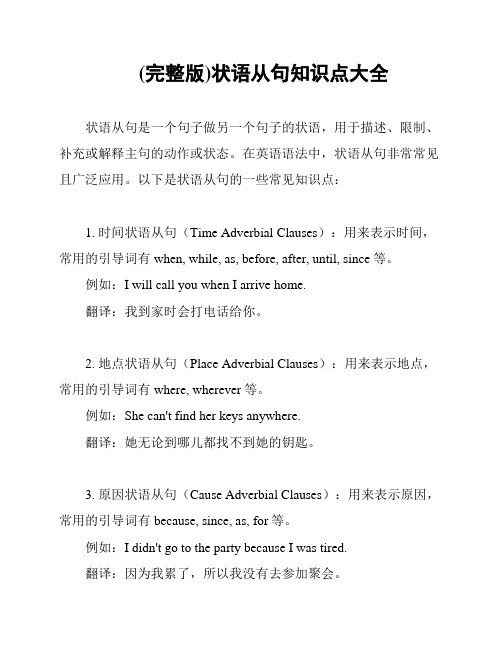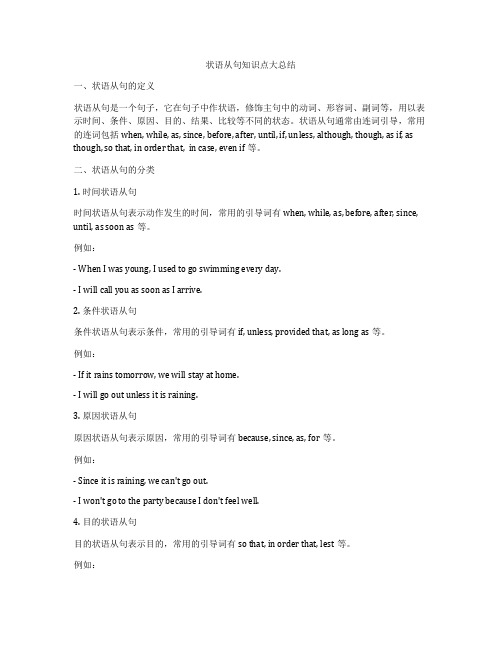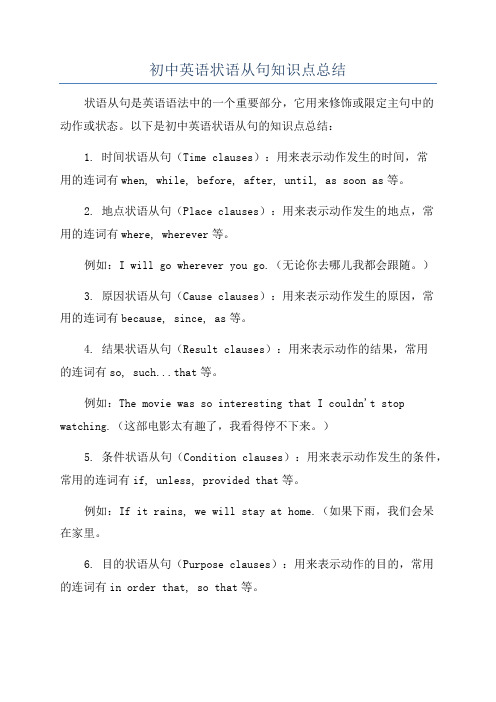英语状语从句归纳总结英语时间状语从句
- 格式:doc
- 大小:34.50 KB
- 文档页数:16

英语状语从句归纳总结英语状语从句是英语语法中的一个重要部分,它可以用来修饰句子中的主谓宾成分,提供更多的信息和细节。
在学习英语状语从句时,需要掌握从句的类型和用法,以下是一些常见的英语状语从句类型及其用法。
1. 时间状语从句时间状语从句用来表示某个动作发生的时间或顺序。
一些常用的时间状语从句包括:when, while, as, after, before, since, until 等。
例如:- When I was young, I used to play basketball with my friends.(当我年轻时,我曾经和我的朋友们一起打篮球。
)- While I was cooking dinner, the phone rang.(当我在做晚饭的时候,电话响了。
)- After I finish this project, I will take a break.(当我完成这个项目后,我会休息一下。
)2. 地点状语从句地点状语从句用来表示某个动作发生的地点。
一些常用的地点状语从句包括:where, wherever, anywhere, everywhere等。
例如:- She always knows where her keys are.(她总是知道她的钥匙在哪里。
)- Wherever he goes, he takes his laptop with him.(无论他去哪里,他都带着他的笔记本电脑。
)3. 原因状语从句原因状语从句用来表示某个动作发生的原因。
一些常用的原因状语从句包括:because, since, as, now that等。
例如:- Because it was raining, we decided to stay indoors.(因为下雨了,我们决定呆在室内。
)- Since you didn't like the movie, we can watch something else.(既然你不喜欢这部电影,我们可以看其他的。

(完整版)状语从句知识点大全状语从句是一个句子做另一个句子的状语,用于描述、限制、补充或解释主句的动作或状态。
在英语语法中,状语从句非常常见且广泛应用。
以下是状语从句的一些常见知识点:1. 时间状语从句(Time Adverbial Clauses):用来表示时间,常用的引导词有when, while, as, before, after, until, since等。
例如:I will call you when I arrive home.翻译:我到家时会打电话给你。
2. 地点状语从句(Place Adverbial Clauses):用来表示地点,常用的引导词有where, wherever等。
例如:She can't find her keys anywhere.翻译:她无论到哪儿都找不到她的钥匙。
3. 原因状语从句(Cause Adverbial Clauses):用来表示原因,常用的引导词有because, since, as, for等。
例如:I didn't go to the party because I was tired.翻译:因为我累了,所以我没有去参加聚会。
4. 结果状语从句(Result Adverbial Clauses):用来表示结果,常用的引导词有so, therefore, thus等。
例如:He studied hard, so he passed the exam.翻译:他努力研究,所以他通过了考试。
5. 条件状语从句(Condition Adverbial Clauses):用来表示条件,常用的引导词有if, unless, provided that等。
例如:If it rains tomorrow, we won't go to the park.翻译:如果明天下雨,我们不会去公园。
6. 目的状语从句(Purpose Adverbial Clauses):用来表示目的,常用的引导词有so that, in order that等。

状语从句的用法归纳总结及用法状语从句是复合句中的一种主从结构,用于修饰、说明主句中的动词、形容词、副词等成分。
它起到补充、限制和修饰主句的作用,使得整个句子更加准确丰富。
在英语写作中,灵活运用状语从句能够提高表达的准确性和语言的流畅度。
本文将对状语从句进行归纳总结,并详细介绍其常见的使用方式。
一、时间状语从句时间状语从句是指修饰主句谓语动词发生时间或时间段的从句。
以下是几种常见的时间状语从句:1. 当/当…时(When)这是表示某个事件或行为发生时机的常见引导词,如:- When I was a child, I used to play in the park.- I will give you a call when I arrive at the airport.2. 每当…就(Whenever)这种类型的时间状语从句指动作在不同时刻重复出现,如:- Whenever it rains, my dog hides under the bed.- The children always get excited whenever they see ice cream.3. 只要…就(As long as)这类状语从句表达的是条件和结果,如:- You can borrow my car as long as you promise to return it before midnight.- As long as you work hard, you will succeed.4. 一…就(Once)这种类型的状语从句表示的是某件事情发生的时候立刻做出反应,如:- Once you finish your homework, you can go out and play.- Once the sun sets, darkness falls quickly.二、地点状语从句地点状语从句修饰主句中动词的地点或方向。

高考英语状语从句知识点知识点复习高考英语状语从句知识点复习状语从句是高考英语中的重要语法知识点之一,掌握好状语从句对于理解和运用英语语言有着至关重要的作用。
在这篇文章中,我们将对高考英语中常见的状语从句类型进行详细的复习。
一、时间状语从句时间状语从句表示时间关系,常用的引导词有 when(当时候)、while(在期间)、as(当时,一边一边)、before(在之前)、after (在之后)、since(自从)、until / till(直到)等。
When 引导的时间状语从句,表示一个动作发生时,另一个动作正在进行或刚刚完成。
例如:“I was doing my homework when my mother came back” (当我妈妈回来的时候,我正在做作业。
)While 引导的时间状语从句,强调主句动作和从句动作在同一时期内同时发生,且持续时间较长。
例如:“While I was reading, my sister was playing the piano” (我在读书的时候,我妹妹在弹钢琴。
)As 引导的时间状语从句,强调两个动作同时发生,或一个动作随着另一个动作的变化而变化。
例如:“As time goes by, we are growing older” (随着时间的流逝,我们渐渐变老了。
)Before 和 after 引导的时间状语从句,分别表示“在之前”和“在之后”。
例如:“Please turn off the light before you leave the room” (在你离开房间之前,请关灯。
)“I will call you after I finish my work” (我完成工作之后会给你打电话。
)Since 引导的时间状语从句,表示“自从以来”,主句通常用现在完成时,从句用一般过去时。
例如:“I have lived here since I was born”(自从我出生以来,我就住在这里。

状语从句知识点大总结一、状语从句的定义状语从句是一个句子,它在句子中作状语,修饰主句中的动词、形容词、副词等,用以表示时间、条件、原因、目的、结果、比较等不同的状态。
状语从句通常由连词引导,常用的连词包括when, while, as, since, before, after, until, if, unless, although, though, as if, as though, so that, in order that, in case, even if等。
二、状语从句的分类1. 时间状语从句时间状语从句表示动作发生的时间,常用的引导词有when, while, as, before, after, since, until, as soon as等。
例如:- When I was young, I used to go swimming every day.- I will call you as soon as I arrive.2. 条件状语从句条件状语从句表示条件,常用的引导词有if, unless, provided that, as long as等。
例如:- If it rains tomorrow, we will stay at home.- I will go out unless it is raining.3. 原因状语从句原因状语从句表示原因,常用的引导词有because, since, as, for等。
例如:- Since it is raining, we can't go out.- I won't go to the party because I don't feel well.4. 目的状语从句目的状语从句表示目的,常用的引导词有so that, in order that, lest等。
例如:- I study hard so that I can get a good job.- We left early in order that we might avoid the traffic.5. 结果状语从句结果状语从句表示结果,常用的引导词有so...that, such...that等。

初中英语状语从句知识点总结状语从句是英语语法中的一个重要部分,它用来修饰或限定主句中的动作或状态。
以下是初中英语状语从句的知识点总结:1. 时间状语从句(Time clauses):用来表示动作发生的时间,常用的连词有when, while, before, after, until, as soon as等。
2. 地点状语从句(Place clauses):用来表示动作发生的地点,常用的连词有where, wherever等。
例如:I will go wherever you go.(无论你去哪儿我都会跟随。
)3. 原因状语从句(Cause clauses):用来表示动作发生的原因,常用的连词有because, since, as等。
4. 结果状语从句(Result clauses):用来表示动作的结果,常用的连词有so, such...that等。
例如:The movie was so interesting that I couldn't stop watching.(这部电影太有趣了,我看得停不下来。
)5. 条件状语从句(Condition clauses):用来表示动作发生的条件,常用的连词有if, unless, provided that等。
例如:If it rains, we will stay at home.(如果下雨,我们会呆在家里。
6. 目的状语从句(Purpose clauses):用来表示动作的目的,常用的连词有in order that, so that等。
例如:I bought a new notebook so that I can take notes in class.(我买了一个新笔记本,这样我可以在课堂上记笔记。
)7. 方式状语从句(Manner clauses):用来表示动作发生的方式,常用的连词有as, as if, as though等。
例如:He speaks as if he knows everything.(他说话的样子就像他什么都知道。
初中英语知识点归纳时间状语从句的引导词和结构时间状语从句是英语中一种常见的句子结构,用来表示时间上的关系。
正确使用时间状语从句可以让句子更加准确和流畅,提高语言表达的准确性。
本文将对初中英语中常见的时间状语从句的引导词和结构进行归纳总结。
一、前置时间状语从句1. 引导词:when(当...时候)、while(当...的时候)、as(当...时候)、before(在...之前)、after(在...之后)例句:- When I was a child, I used to play with my friends in the park.- While he was cooking dinner, the phone rang.- As I was leaving the house, I remembered to take my umbrella.- Before I went to bed, I finished my homework.- After she finished her work, she went shopping.2. 引导词:once(一旦)、as soon as(一...就)、the moment(一...就)、the minute(一...就)例句:- Once you start reading this book, you won't be able to put it down.- As soon as the bell rang, the students rushed out of the classroom.- The moment she saw him, her face lit up with joy.- The minute I arrived at the station, the train left.二、后置时间状语从句1. 引导词:when(当...时候)、while(当...的时候)、before(在...之前)、after(在...之后)、until/till(直到...的时候)、since(自...以来)例句:- I will call you when I arrive at the airport.- She likes to listen to music while she's doing homework.- I went to bed before it started raining.- After she finished her meal, she paid the bill and left.- He didn't speak up until/till the end of the meeting.- Since you have been away, many things have changed.2. 引导词:once(一旦)例句:- You will succeed once you put enough effort into it.三、并列时间状语从句1. 引导词:when(当...时候)、whenever(无论何时)、while (当...的时候)、as(当...时)例句:- You can come to my house when you have time.- Whenever I see a dog, I can't help but smile.- While I was reading a book, my brother was watching TV.- As she was walking in the park, she saw a beautiful flower.2. 引导词:before(在...之前)、after(在...之后)例句:- I will finish my homework before I go out to play.- After she finished her lunch, she went for a walk.以上是初中英语中常见的时间状语从句的引导词和结构的归纳总结。
状语从句知识点总结一、状语从句的定义状语从句是在复合句中作状语的从句,它用来修饰主句中的动词、形容词或其他副词,表示时间、地点、原因、条件、让步、目的等语义内容。
二、状语从句的类型1. 时间状语从句:表示动作发生的时间。
- 常见引导词:when, while, as, after, before, until, once, as soon as 等。
- 示例:I will call you when I arrive in London.2. 地点状语从句:表示动作发生的地点。
- 常见引导词:where 等。
- 示例:Practise pronunciation where possible.3. 原因状语从句:说明原因或解释。
- 常见引导词:because, since, as, seeing that, now that 等。
- 示例:She can't attend the meeting because she is ill.4. 条件状语从句:表示条件或假设。
- 常见引导词:if, unless, provided that, as long as, on condition that 等。
- 示例:We will go on an outing if it doesn't rain.5. 让步状语从句:对主句内容进行让步或转折。
- 常见引导词:although, though, even though, despite, in spite of 等。
- 示例:Despite the bad weather, we went for a walk.6. 目的状语从句:表示目的。
- 常见引导词:so that, in order that 等。
- 示例:He gets up early so that he can catch the first bus.7. 结果状语从句:表示结果。
初中英语知识点归纳时间状语从句的引导词和构成时间状语从句是英语语法中的重要部分,它用来描述一个动作或事件发生的时间。
在句子中,时间状语从句通常由引导词引导。
本文将对初中英语中时间状语从句的引导词和构成进行归纳总结。
一、引导词的分类1. 引导从句表示时间点的引导词:when,while,as soon as,once,before,after,since,till/until,as,no sooner...than等。
例如:- I always feel sleepy when I study late at night.(我晚上学习到很晚时总是感到困倦。
)- Maggie was doing her homework when the phone rang.(电话响起时,Maggie正在做作业。
)- As soon as I finish this book, I will lend it to you.(一旦我完成这本书,我就会借给你。
)2. 引导从句表示时间段的引导词:while,when,as,as long as,once,whenever等。
例如:- I will stay here as long as you need my help.(只要你需要我的帮助,我就会一直呆在这里。
)- Whenever you come to Beijing, please let me know.(无论什么时候你来北京,请告诉我。
)3. 引导从句表示相对时间的引导词:before,after,since,until/till,while等。
例如:- I had a shower before I went to bed.(我在睡觉前冲了个澡。
)- They had been waiting for the bus since three o'clock.(他们从三点钟开始就一直在等公交车。
)- Please wait here until/till I come back.(请在这里等我回来。
一、时间状语从句时间状语从句用来表示时间关系,常由连词“当……时候”、“随着”、“一旦”、“随时”、“直到”、“自从”等引导。
例如:1.当我在家里的时候,我妈妈总是在旁边看着我。
2.随着天气的转暖,我们就可以去郊游了。
3.一旦你有了问题,就可以找我帮忙。
4.随时都可以来找我,我随时都在。
5.直到你完成这个任务,我才会离开。
6.自从我来到这个城市,我就没有回过家。
二、地点状语从句地点状语从句用来表示地点关系,常由连词“在……地方”、“位于”、“从……起”、“直至”等引导。
例如:1.在这个超市里,你可以找到各种各样的商品。
2.位于市中心的位置,使得这个商场非常繁华。
3.从这家公司起,我们的合作就一直非常好。
4.直至你找到工作,你就可以安心了。
三、原因状语从句原因状语从句用来表示原因关系,常由连词“因为”、“由于”、“鉴于”等引导。
例如:1.因为我今天不舒服,所以我不想去上课。
2.由于天气的原因,我们取消了郊游计划。
3.鉴于你的表现,老师给了你很高的评价。
四、条件状语从句条件状语从句用来表示条件关系,常由连词“如果”、“只要”、“除非”、“只要……就”等引导。
例如:1.如果明天不下雨,我们就去郊游。
2.只要你能努力,你一定能成功。
3.除非你道歉,否则我不会原谅你。
4.只要你想明白,你就会知道我为什么这样做。
五、目的状语从句目的状语从句用来表示目的关系,常由连词“为了”、“以便”、“好”等引导。
例如:1.为了能更好地学习,他每天都很努力。
2.以便你能理解,我解释得很详细。
3.好让你明白,我特意给你举个例子。
六、结果状语从句结果状语从句用来表示结果关系,常由连词“所以”、“因此”、“结果”、“从而”等引导。
例如:1.所以他没能来,因为他生病了。
2.因此我们决定,明天再去郊游。
3.结果这个方法很有效,我们很快就完成了任务。
4.从而使我们的工作更加顺利。
一、时间状语从句时间状语从句用来表示时间关系,常由连词“当……时候”、“随着”、“一旦”、“随时”、“直到”、“自从”等引导。
英语状语从句归纳总结英语时间状语从句状语从句1.时间状语从句(1) whenwhen用作并列连词(正在那时,突然)We were about to start when it began to rain.Iwas watching TV when someone knocked at the door.…on the point of doing…when… did… ……had just done when …… (2) as as与延续性动词连用,侧重两个动作伴随发生,其时态一致:As he grew older he lost interest in everything except gardening.We were having breakfast as she ________( watch )TV.(3)while while “在……期间”,与延续性动词连用,和主句的动作同时发生,常用三种时态。
1.WhileI was waiting at the bus stop, buses went by in the opposite direction.2.While in prison, he wrote his first novel.3.Shoeswere mended while you waited.(4) before ① before“在……之前” I had finished my papers before my teacher went abroad.②before “过…时间之后才…”, 注意使用 ___________和___________时态。
They worked long hours before everything returned to normal.恢复正常It will be a long time before we finish this dictionary.③ 还没来得及 The bell rang off before I could answer it.(5)as soon as “一… 就….”, directly,immediately,instantly;the instant (that),the minute (that) ,the second (that) ,the moment (that)等通常都可与as soon as换用。
I recognized her immediately I saw her.(6) … hardly...when … / … no sooner...than… “刚……就…”,从句用过去时,主句用过去完成时。
注意倒装。
He had no sooner / No sooner had he arrived than he was asked to leave again.We had hardly begun / Hardly had we begun our talk when it began to rain.(7) since 从句用一般过去时,主句通常用现在完成 (进行) 时.We’ve never met since we graduated from thecollege.Whathave you been doing since I met you last time? It has been / is 3 years since he came back.练习:Itwas evening ______ he came back.Itwas in the evening ______ he came back.(8)till / until “直到……时(为止)”,till 不放在句首,until多用于句首。
动词的延续性问题 Tom will remain in college until (till) he finishes his Ph.Dcourse.肯定句I won’t go with you until (till) I finish my homework.否定句Not until I failed in the exam did I realize I should study hard.倒装 It was not until I failed in the exam that I realized I should study hard.在强调句中的倒装问题 (9) whenever / each time / every time / any time “每当;每次”,可以换用。
Whenever / Every time / Each time I met her, she was studying.(10)by the time 与完成时连用 By the time (that) this letter reaches you, I will have left the country.By the time he was10, he had learned10000 words.Bythe time you get this letter, I will be in Canada.( Longman ) be动词可不用完成时注意:By the time he retired, Wilt held many NBA records.(11)next time, the first time Next time you see me, I will have lost10 pounds.Thefirst time I met you, I knew we would be friends.比较:That/ It / This is the first time (that) I have been to London.Forthe first time 仅用作状语 (12) After We’ll arrive after you have left.2.地点状语从句(1) where Where there is a will, there is a way.含有条意味I found my books where I had left them.注意:where除指具体地点外,还可表处境等抽象意义。
He said he was happy where he was.处境很满意It’s your fault that she is where she is.她落到今天这个地步都怪你。
(2) wherever =everywhere, anywhere Wherever ( Everywhere / Anywhere ) they went, the experts were warmly weled.Makea mark wherever you have any questions.区别与其引导定语从句Bamboos grow best in the south where it’s wet and rainy.3.原因状语从句 (1) because because表示直接的原因或理由,着重点在从句。
用于回答why问句,语气最强。
强调句中用because。
被simply, just, only修饰时用because。
I didn’t go abroad with her because I couldn’t afford it.Justbecause I don’t plain, people think I’m satisfied.It was because his mother was ill that he didn’t e to school.小结:because1 ._______2._________3._________4.__________ (2) as 因为,由于 As you were out, I left a message.(3) since 通常是双方已知信息,从句多位于主句之前。
Since you won’t help me,I’ll ask someone else.(4) now (that) “因为, 既然, 由于”,通常可以和since 换用。
其中that可省去,原因往往是已变化的情况。
Now (that) you’ve passed your test you can drive on your own.Ido remember,now (that) you mention it.你这一提,我倒的确想起来了。
(5) when 既然,从句必须在后 How can they expect to learn anything when they never listen? Why do you want a new job when you have got a good one already? (6) seeing (that) ;considering(that);Given that “鉴于;由于;考虑到” Seeing (that) the weather is bad,we’ll stay at home.Considering he’s only just started, he knows quite a lot about it.It was surprising the government was re-elected, given that they had raised taxes so much.(7) for 并列连词,不用于句首,对前面内容加以推断或解释 I asked her to stay to tea, for I had something totell her.It’smorning now, for the birds are singing.4.目的状语从句须与情态动词连用 (1) in order that “为了;以便” 通常可以与so that换用。
The expert spoke slowly in order that everyone should understand.Inorder that we might see the sunrise, we started for the peak (山峰) early.(2) so (that) ; so that “为了;以便”。
从句总是放在主句之后,so可视为so that的省略形式。